J.R.R. Tolkien nerds like me already know there’s a new book out—Beren and Lúthien—that again demonstrates that the Professor continues to release great stuff even from beyond the Circles of the World. Now, if you don’t really know much about these two characters, the titular Man and titular Elf, consider delving into their tale at long last! In one of many letters to his publisher, Tolkien had pitched theirs as “the chief story of the Silmarillion,” but more importantly, the tale of these two lovers was extremely close to the heart of the good ol’ Professor himself. Beren and Lúthien are like ripples in the Middle-earth legendarium, touching everything in all directions.
I previously wrote an article about Lúthien showcasing the badassery of the Elven half of this particular celebrity couple (Berúthian?), but this time I’d like to look at the new book itself, discuss some of its outrageous ideas, and admittedly go all fanboy on the real hero of the story (hint: he’s such a good boy). And of course, I talk about this story in the appropriate chapter of The Silmarillion Primer. But here’s a sneak peek of Beren and Lúthien:
Sauron’s a kitty-cat and Gimli’s an Elf. Wait, whaaaat?
Just an honest disclaimer: what follows is a basic review, a discussion of some of its livelier elements, and a spate of thoughts and near-digressions. Oh, and plenty of spoilers, should that matter. (Tolkien himself didn’t seem to care much about spoiler alerts, but that’s a topic for another day.)
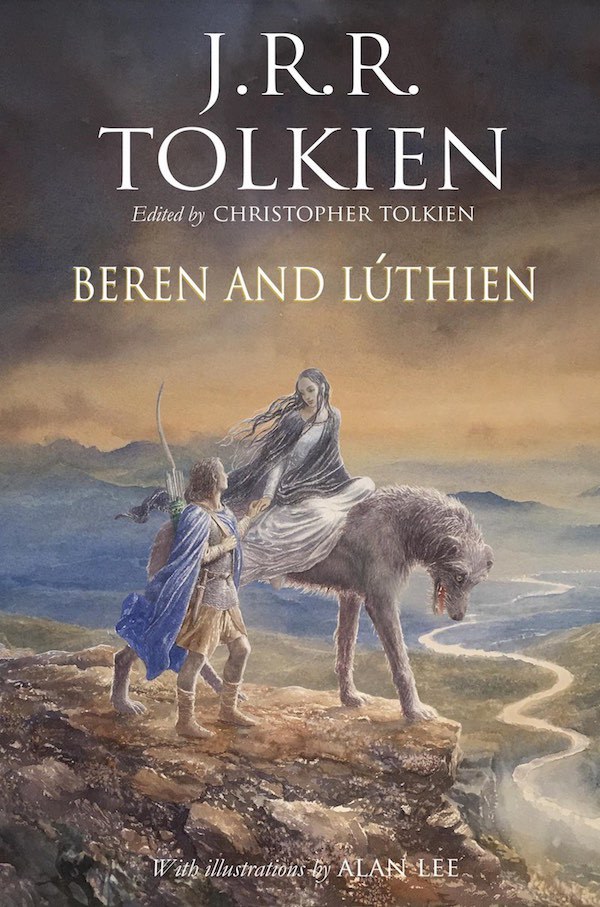
When I first heard about this publication—a new Tolkien book in 2017?!—I was super excited. Beren and Lúthien’s have always been my favorite pre-LotR story, and I know I’m not alone in that. I was hoping it would get the Children of Húrin treatment, which is to say that the book would be the novelized form of another particularly memorable chapter from The Silmarillion. Thus greater details from the story would surely emerge, as they did for Húrin! In that book, previously unnamed characters popped up—like the friendly old servant with the missing foot, and the woodsy young Elf who remained childlike in heart—and all kinds of new dialogue enriched the tale…the terrible, horrible, no good, very grim tale of Túrin Turambar.
So in the same vein, I hoped for further intel about Beren’s quest for the Silmarils, which is what this story is essentially about. I wanted to know more, for example, about Thuringwethil! She was some sort of leathery-winged, iron-clawed vampire in the service of the great enemy, Morgoth—or, at least she was before becoming Lúthien’s personal Batgirl costume. All we really got in The Silmarillion was her name (which meant “Woman of Secret Shadow”) and job title (“messenger of Sauron”).
Or, if not further details about Thuringwethil, maybe we’d at least learn more about the Leap of Beren. Which was, according to The Silmarillion, “renowned among Men and Elves” but it’s never said why. He used it to bear down on a douchebag Elf who was trying to abscond with his girlfriend, but just how had the ability to jump earned proper noun status, and where else might Beren have leaped so magnificently and so memorably? Could he hop rooftop to rooftop like the Tick? Leap fantastic distances like John Carter on Mars? Over tall buildings in a single bound like the Man of Steel? He might have been a hero, but he was still just a Man. I needed to know. Surely this new book would tell all.
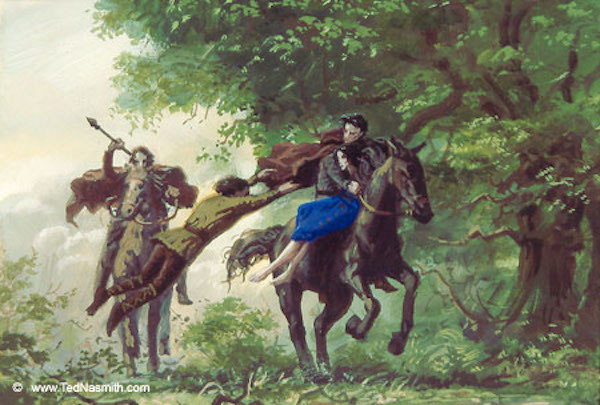
Alas, it does not. So it looks like we’ll only know more about the Leap of Beren when we also find out how many licks it takes to get to the Tootsie Roll® center of a Tootsie Pop®.
Christopher Tolkien is forthcoming about this in his Preface; the book “does not offer a single page of original and unpublished” text of his father’s. Which is certainly a bummer. But what the new book does do is hold up a big, old-timey, Sherlock–style magnifying glass to the story and its evolution. Like almost everything published posthumously under the Tolkien name, it is comprised of J.R.R.’s unfinished scrawlings tied up and edited into a cohesive narrative by his son. And Christopher—now in his 90s—does it thoroughly, taking on the task of chronologically contextualizing each snippet. That’s no easy job—have you seen Tolkien’s handwriting? Plus, Beren and Lúthien includes nine amazing-as-always Alan Lee paintings and a slew of beautiful sketches throughout.
There’s also a wonderful little chapter Christopher Tolkien provides after the Preface called “Notes on the Elder Days,” and it helps set the stage for those who don’t already know how this story connects to LotR or what’s going on in the First Age up until this point. Specifically, it fills readers in on who the hell Morgoth is, what this land called Beleriand is that we never see on any LotR maps, and what the deal is with the Elves and why they’re so center stage at this point in time.
Ultimately, the book presents the Beren and Lúthien story as it developed in the real world, from its earliest beginnings as a simple, unattached fairy tale to its ultimate placement as a key episode in the history of Middle-earth. Remember, the official incarnation is “Of Beren and Lúthien,” Chapter 19 in The Silmarillion. But these two characters don’t spring up out of nowhere—their lineage and their lives up until the moment of their meeting in the woods of Doriath are rich indeed—and yet their union becomes pivotal in the threads that bind the origin of Arda itself to the major players of the Third Age and the shenanigans of that Ring-making Dark Lord with whom we’re all much more familiar. Through Beren and Lúthien “the first marriage of mortal and immortal is achieved,” and Lúthien’s own momentous choices even set down new precedents for the fates of their respective races.
The texts in Beren and Lúthien are primarily taken from the publications The Book of Lost Tales, Part Two (1984, “The Tale of Tinúviel”) and The Lays of Beleriand (1985, “The Lay of Leithian”), since these include early versions of the Beren/Lúthien legend. And I do mean early: Tolkien’s first writings about Beren and Lúthien began in 1917 while he was on sick leave from the British Army in the Great War, long before The Hobbit, The Lord of the Rings itself, and all the legendarium-building that followed. Famously inspired while watching his wife dancing in a glade of hemlocks, Tolkien conceived the story and it took on many shapes throughout his life.

First we get The Tale of Tinúviel, the earliest recoverable version of the story, wherein Beren is not a Man at all but a Gnome, an Elf-like species normally considered “treacherous creatures, cruel and faithless” by other Elves. Lúthien herself is known only as Tinúviel and she is the Princess of Fairies (fairy being synonymous with Elf here). In this version, there is no political element—no sons of Fëanor, no Nargothrond, no Finrod—and everyone’s big enemy is named Melko (he’s just not quite as wicked without that terminal “r”). And good old Huan, the dog to end all dogs, still shows up. But he talks a lot more—like, a lot more—and he’s also got an epithet. Here, he’s the Captain of Dogs. Milkbones for everyone!
The most entertaining aspect of this early draft is that the role that Sauron later assumes—the sub-arch-villain who holds Beren captive early in his quest—is here played by Tevildo the Prince of Cats! Tevildo’s an evil “fay” who takes the form of a great big black kitty with a golden collar, and he rules over all the giant cats, who in turn are made large and strong by his mastery; they spend their days sunning themselves on terraces.
Let me say that again. Tevildo the Prince of Cats. Tevildo. Evil is almost literally his middle name.
When he has Beren in thrall, he doesn’t torture him like Sauron will in later incarnations of the tale; sure, Beren gets scratched and bitten, but mainly he’s made to do menial work in the kitchens of Tevildo’s castle! Unspeakable indeed. Huan gets involved and helps Tinúviel free her man from enslavement/scullery duties and actually does most of the leg work. And yes, there is of course great enmity between Tevildo and Huan already, as they get on like cats and dogs even in this nascent Middle-earth. In this version, Huan’s all too happy to help Tinúviel with a plan for rescue, for he is, as he declares, “Huan of the Dogs, chief foe of Tevildo.”
In my earlier Lúthien article I pointed out that our heroine was breaking stereotypes for women in fantasy back when The Silmarillion came out in 1977, but actually, this story got started sixty freakin’ years earlier. That is to say, it was a very young and lovesick Tolkien who wrote about a very liberated woman who breaks her own damn self out of a prison-tower (okay, a very tall treehouse) and then saves her own goddamn boyfriend. Hell, the phrase “Lay of Leithian” is said to mean “release from bondage.” From the get-go, Lúthien was no rescued princess. This badass maiden always had mad skills and the backbone to get stuff done. Then again, this incarnation of Lúthien also does a lot more crying, so maybe it evens out. Even so, the partnership of Beren and Tinúviel is kick-ass and rock solid.
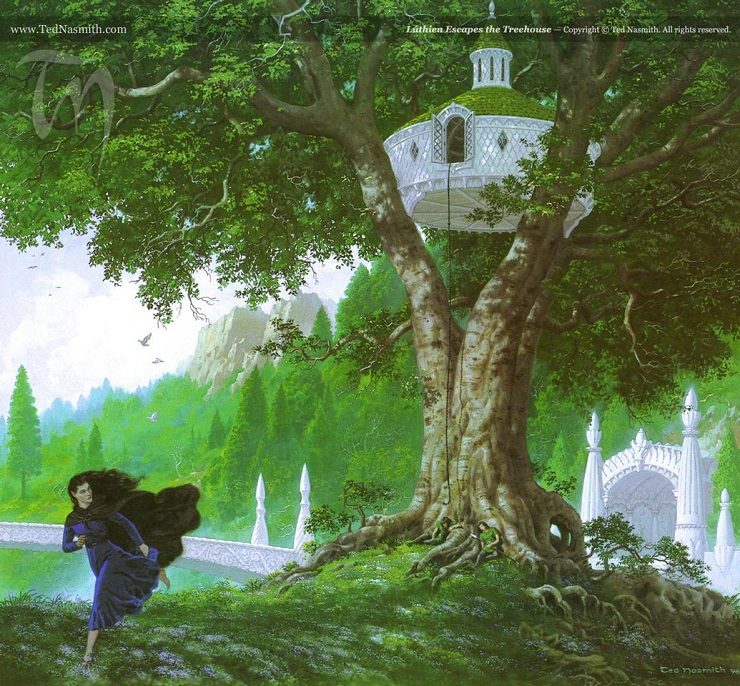
To me, the whole Tale of Tinúviel actually reads like a twentieth-century storybook fairy tale, more like The Hobbit in its more whimsical moments than the serious-minded, and at times far graver, LotR. There are even moments that sound like more familiar, less Tolkienesque fairy tales, demonstrating that young J.R.R. was still finding his own voice.
For example, in the account of Tinúviel’s escape from the great beech treehouse, she secures her exit by tricking her guards into fetching the ingredients of a spell: water drawn from a spring at midnight in a silver bowl, wine delivered in a flagon of gold at noon (which the guard must deliver while singing), and a spinning wheel. Thus she weaves her magic and grows her hair crazy long. Then there’s this little unexpected, not-quite-relevant moment when Beren and all the other prisoners of Tevildo’s castle are set free. Tolkien specifically calls out one of them, a blind old Gnome (aka Noldorin Elf) named…Gimli! And then he just moves on with the story, and we never hear from our Gimli’s namesake again. The Tale of Tinúviel is a delight to read, but at the same time, I’m very glad Tolkien revised it.
All the other incarnations and extracts of the story follow. Some of the names change, and the lands and politics of Middle-earth begin to slide into place around it. By this point, Beren is no longer a Gnome but a proper Man, and very much mortal—a key point in the long run, after all. And though Lúthien is essentially the same, Tevildo is now replaced by the necromancer Thú, the Master of Wolves and greatest lord of Morgoth (previously known as Melko). And here, of course, we see the real beginnings of our good friend Sauron—his actual promotion to Sauron from Thú comes a bit later in Tolkien’s life.
These pre-Silmarillion versions are presented largely in verse, as Tolkien had first devised them because he was a linguist and medievalist; epic poems like Beowulf were his jam! Now, I’ve never studied much poetry beyond a few college classes, so I’m no expert on the subject, but to me the “The Lay of Leithian” has some of the most evocative, even cinematic verse ever. It brings gravity and power to the story in ways even The Silmarillion does not.
Although to its credit, even The Silmarillion doesn’t skip on the poetic form of Finrod’s mighty sing-off with Sauron in the first half of the story. It shows you that immortal First Age combatants don’t always draw swords; contests of will are spiritual battles. Considering that Ilúvatar brought the world itself into being with great choirs, it’s no surprise that music plays a vital role in the “magic” of Arda. And it’s easy enough, maybe, to imagine an Elf like Finrod Felagund spilling forth power like some 18th-level elf bard in D&D with a harp and some marvelous lyrics, but it’s another to imagine Thú/Sauron himself singing. But no, it’s not so crazy. He is a Maia, and would have participated in the Music of the Ainur at the beginning of creation. He had music before any physical manifestation at all, before the world was made.
And because we do live a world where Christopher Lee once put out actual symphonic metal albums and won an award called the Spirit of Metal, it’s just as easy to imagine Sauron whipping out a B.C. Rich Ironbird Pro while “chanting a song of wizardry” before the “[t]hunder rumbles” and “fires burn.” Power chords indeed. Or maybe—and this might just be me—launching into a prog rock bass solo. Maybe slappin’ da bass like Geddy Lee.
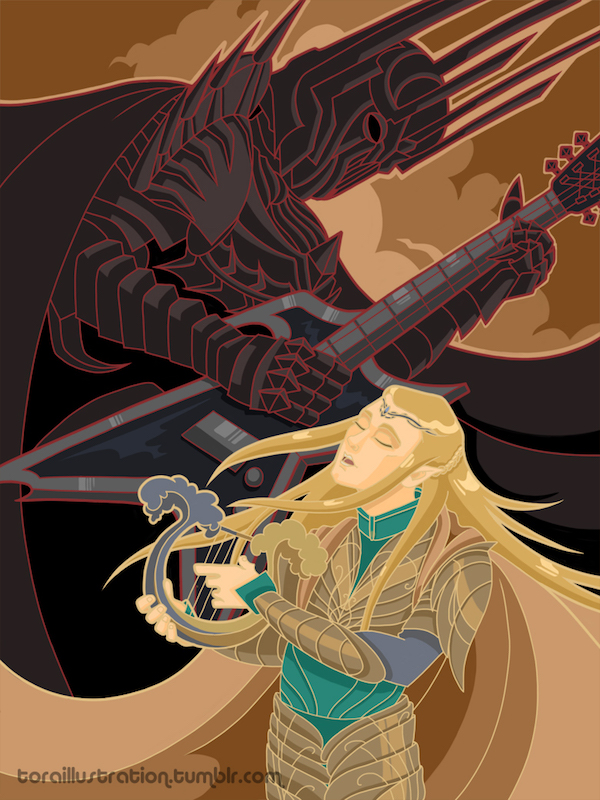
But I digress. So not only does “The Lay of Leithian” present pieces of the story in a beautifully rhythmic form, it provides some rich detail eventually glossed over in The Silmarillion. One of my faves is when Beren and Lúthien are about to embark on the last leg of their quest and journey into Angband, Middle-earth’s own hell. Because of Huan, they’ve got the skins of Draugluin, the ex-daddy of all werewolves, and Thuringwethil, the aforementioned vampire she-bat. Lúthien does more than simply have them put on gross beast coats for disguise; by her arts, the skins transform them into these monstrous shapes as well, and they become even in their minds a bit like the werewolf and vampire.
Swift as the wolvish coat he wore,
Beren lay slavering on the floor,
redtongued and hungry; but here lies
a pain and longing in his eyes,
a look of horror as he sees
a batlike form crawl to its knees
and drag its creased and creaking wings.
Then howling under moon he springs
fourfooted, swift, from stone to stone
from hill to plain—but not alone:
a dark shape down the slope doth skim,
and wheeling flitters over him.
But not alone. That’s romantic as hell, in my opinion. And I’m sorry, but forget cooking classes. Opposing the Dark Enemy of the World, together as a couple, is really going top-shelf on date night ideas. These two are valorous, uncompromising, and certainly in over their heads, but they go balls-to-the-wall to achieve it. (What, it’s an aviation expression!) Remember, it was Beren who swore to recover a Silmaril from the crown of Morgoth to win her hand, but because of Lúthien’s devotion to him, he doesn’t fly solo. Nor could he have succeeded without her. It’s not every girl who’d slap around Sauron and then turn into a monster-bat for a relationship.
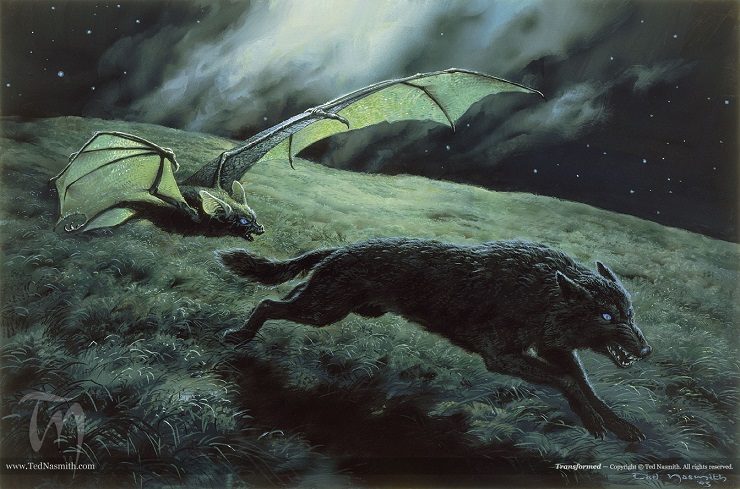
But as a farm boy once said, “This is true love. You think this happens every day?” But actually, no—Lúthien is like Princess Buttercup if she’d gone seeking the Dread Pirate Roberts herself, or Penelope if she didn’t wait for Odysseus but charted her own ship into the middle of his (mis)adventures—though with that analogy, Odysseus would also be faithful to her. Sorry if I’m belaboring a point. Lúthien just that cool, and Beren would do anything for her, and by their devotion both are increased.
There comes another moment later, when Beren and Lúthien do reach Morgoth’s unholy court, that didn’t make the cut in The Silmarillion but is in this book presented again. Beren is a mere mortal and is instantly overwhelmed by the Dark Lord’s presence, slinking down at Morgoth’s feet. Thus in their moment of truth, Lúthien, as the daughter of a mighty Elf king and mightier Maia queen, must take on Morgoth alone. She uses her voice and her spell-woven cloak to beguile him and cast him into his slumber. And here’s where Christopher Tolkien offers this tidbit from the tale:
—what song can sing the marvel of that deed, or the wrath and humiliation of Morgoth, for even the Orcs laugh in secret when they remember it, telling how Morgoth fell from his chair and his iron crown rolled upon the floor.
They do!? We know from all the canon texts that Morgoth’s, and then later Sauron’s, minions and monsters are really just slaves who serve out of fear and domination, never from any sense of loyalty. They hate their masters, in fact, but as far as I know it’s never been shown that they would dare “laugh in secret” whenever one is knocked down a peg. It’s these little glimpses of Tolkien’s behind-the-scenes that I find most fascinating, and why I enjoy books like this one.

My conclusion is that Beren and Lúthien is a fine book, very worth owning. But here’s the thing: you’ve got to appreciate Tolkien’s writing, and a lot of behind-the-scenes lore, to make this a meaningful purchase. Even the explanations provided by Christopher Tolkien between all the difference excerpts can be tangly. If this book also included, in its entirely, “Of Beren and Lúthien” from The Silmarillion, then I would be quick to recommend this book to everyone as the perfect gateway to all of Tolkien’s works beyond The Lord of the Rings. The characters are interesting and approachable, and their story has many connections to LotR, both thematic and literal. But ultimately, I do think this may be a book only for fans already sold on the Beren and Lúthien story. Just as, in the same way, I wouldn’t recommend The Adventures of Tom Bombadil for those who don’t particularly like that gonzo yellow boot fetishist’s placement in the Lord of the Rings itself.
But before I wrap up, I need to go back to Huan. Oh, Huan. Not enough ink has been spilt in honor of the Hound of Valinor, if you ask me—and don’t get me wrong, he does plenty in this book. Heck, no one does more for the eponymous lovebirds of this story than this big-hearted wolfhound. Sure, I was hoping to have more of him, just as I’d hoped for more about the legendary Leap of Beren, but I must be content to revel in his awesomeness as the greatest dog in the world just as is. The poetry brought in from “The Lays of Beleriand,” at least, provides more detail about the loveable pooch.
In brief, Huan was one of many hounds in the Blessed Realm of Valinor, and the Vala known as Oromë the Huntsman was their keeper. And long, long before Beren came along, back before the great screw-up of Fëanor and his seven sons, Huan was an adorable puppy (I assume):
In Tavros’ friths and pastures green
had Huan once a young whelp been.
He grew the swiftest of the swift
and Oromë gave him as a gift
to Celegorm, who loved to follow
the great god’s horn o’er the hills and hollow
It goes on to say that when the great Elf prince Fëanor made his terrible oath and led the Noldor out of Valinor, enacting a series of unfortunate dissents, Huan was the only hound to go, too. Specifically, he stayed with Celegorm, who is arguably one of Fëanor’s most dickish sons. And through their adventures together (which we largely don’t know about), he saved his master “from Orc and wolf and leaping sword.” So hundreds, possibly thousands, of years before he got to meet the way, way better Lúthien, he was loyal to Celegorm. And hey, he’s a dog. Dogs tend to love unconditionally. And Huan strikes me as the sort of character who sees the good in everyone, or tries to. Who knows? Maybe he was a great master for all those centuries.

Pretty much the first thing we learn about Huan when we meet him in The Silmarillion is that he’s faithful. To a fault, you have to figure, to stay saddled to so haughty an Elf. But, you might say that Huan—immortal Huan the Big Grey Dog—had a purpose all this time. He stayed true to Celegorm only until the Elf finally crossed a line and tried to run Beren through with a spear. (Incidentally, Huan’s forsaking of Celegorm happens right after the Big-Ass Leap of Beren.)
Whether by his own will, or by the unseen hand of Ilúvatar, this wolfhound will end up saving both Beren and Lúthien many times over, and give them great advice which helps them get their act together. Then he goes on to personally slay werewolf after werewolf at Sauron’s door. Then he takes on Sauron himself and with Lúthien’s help beats him. And in the end of the quest Huan tangles with prophesied “mightiest wolf” Carcharoth the Red Maw—and dies for it. And because he does this, possessing every bit of agency and mettle as any two-legged fantasy hero (if not more so), he allows for everything, and everyone, that follows to be possible.
See, without Huan’s help, there would have been no more Beren and no more Lúthien. And then we’d not have met their son Dior, the very first of the Half-elven. Dior’s mother had, upon Beren’s death, traveled in spirit to the Halls of Mandos to sing her lament and thereby win some new rules concerning the fate of all the Half-elven to come. These individuals of Man and Elven blood are each given the choice to be “counted among” Men or among Elves (but not both). They either remain immortal like the Elves and live as long as Arda itself does, or else choose to become mortal, like Men, and eventually die and go beyond the Circles of the World, where even the Valar cannot speak to their fate. Only Ilúvatar knows what purpose Men will have in the long run, and by Lúthien’s choice she will go with Beren thence. Thence, I say!
So the only daughter of Dior turns out to be Elwing, who marries Eärendil the Mariner (whose own tale is decidedly splendiferous), and their sons will be Elros and Elrond. From Elrond and his wife, Celebrían (daughter of the Lady of the Golden Wood!), we will eventually meet Arwen Undómiel—who is herself likened to Lúthien on many accounts and certainly shares her doom. And Elrond’s brother, Elros, will choose to be counted among Men, but he’ll also become the first king of Númenor. And from that powerful but ultimately ill-fated lineage of Men we will finally meet Aragorn many, many generations later. You might have heard of him?
And this is all because a particularly loyal hound stayed true to a not-so-stellar master for years uncounted, holding out for the better people in his life who would bring out his true purpose. What I’m saying is, If J.R.R. Tolkien and W. Bruce Cameron could have co-written a book, it would have been titled A Dog’s Purpose Full-Wrought. Damn it, I want to read that book so much. It would tell Huan’s entire story, from litter to cairn, and explain how he put up with that jerkface Celegorm for so long, so he could, in turn, become friend and co-conspirator and wolf-slayer and counselor to a guy named Beren and a girl named Lúthien. And the whole thing about Huan being given the power of speech only three times in his existence, and yet his choosing to save all three occasions toward the end of this long life, just for the benefit of those two? Yeah, he’s a Good Boy. He probably wasn’t even scared of vacuum cleaners.
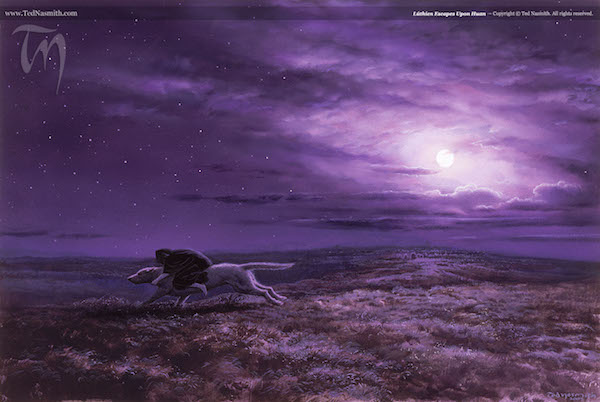
As for learning more about that Leap of Beren, well, it looks like the world will have to wait. I’m not one for fan fiction, but if I were to try to flesh out this legend, I would have wanted to include some new dialogue between our hero and Lúthien’s father, Thingol, when they meet for the first time, what with all that high tension in the king’s court.
Therefore Lúthien spoke, and said: ‘He is Beren son of Barahir, lord of Men, mighty foe of Morg—’
‘Wait!’ Thingol interrupted, clearly flabbergasted. ‘Not Beren…of the Leap of Beren?!’
‘The same,’ Beren replied.
Seriously, that guy could jump. Or so we’re told.
Jeff LaSala received the Ring of Barahir from his wife as a counter-engagement ring many years ago. He is responsible for The Silmarillion Primer, listens to The Prancing Pony Podcast and/or the Tolkien Professor for his routine Middle-earth fix and writes sci-fi and/or fantasy when he can find the time (and sleep).











With apologies to J.R.R. Tolkien, artist Randy Vargas, and author W. Bruce Cameron for this blasphemous mock-up, but I want this book to exist very much. :)
I loved this book for among many other reasons our third kitty was named Tevildo.
Christopher in his introduction mentions “the atrocious Tevildo, who deserves more attention than his brief literary life allows.” There is even a wonderful illustration (plate #2) of Tevildo and his henchcat stalking Luthien, presumably about the time he sniffs her and says “I smell dog.”
Everyone loves the big chihuahua with delusions of eloquence Huan but the concept of an evil cat who punishes Beren by making him wash dishes is just too wonderful to pass up…
Regarding the fate of Luthien:
She joined Beren beyond the circles of the world (presumably in Iluvatar’s halls) whereas the Elves like the Valar are stuck in the Created World until the End (and their place after that is unknown). So Luthien is the only one to Get Out, at least until Arwen (and her brothers but that’s definitely another discussion). So Leithian, Release from Bondage has yet another meaning: Luthien was released from bondage to creation and went to join Iluvatar…
I enjoyed this article very much (as I do all of your articles, Jeff), but the addition at comment #1 was the real cherry on the top :)
Celebrinnen, thanks. If I got one eye roll, groan, or thumbs-up about that image, it’s been worth it. :)
Dr. Thanatos, quite right. And before Arwen, I’m not sure if we got Dior’s choice but I know we got Elros’s (he became mortal). That’s a sad parting between brothers. Elrond sailing to Valinor at the end of The Lord of the Rings is thus especially melancholy. At least Galadriel would be reuniting with all of her friends and family, but Elrond loses both brother and daughter. His parents, at least, chose to be counted among Elves. Although I should say “loses” with quotes, because no one knows Ilúvatar’s plan for after the end.
And yes, I think there should be some more Tevildo cats out there in the world, to honor the first.
And just for fun, what if Tolkien had kept Tevildo, and Sauron—though the concept of a “fay” might go away—was still in some way a giant terrible cat.
@5 excellent poem!
I note that in the end of the Foreward, JRRT tells us that Celeborn dwelt for a time with the sons of Elrond before departing and when he went there went the last living memories of the Elder Days.
1) So the sons of Elrond also stayed when he left. But no, it’s ALWAYS about Arwen; SHE looks like Luthien; SHE chose mortality and broke Dad’s heart; Dad always liked her best.
2) Celeborn took the last living memories of the Elder Days? The only way this could happen would be if the ship he sailed on was the SS Don’t Be Hasty, Put that Ax Down.
1) Are you saying Arwen is the Prodigal’s Daughter?
2) “Run, Forest, run!”
Although to be fair, even though Treebeard might theoretically have the last living memories of the Elder Days, I think it’s safe to assume his memories were of very different things. Elrond and his sons would have knowledge and memories of many political events; Treebeard’s would concern the natural world only. Remember, even Hobbits slipped under his radar—not to mention the Entwives.
@5, Luv the cat “One Ring” verses! :)
And what about the cats of Queen Berúthiel? :)
@8,
Ah, the cats of Queen Beruthiel, last children of Tevildo to trouble the unhappy world…
As an aside, does anyone know where it was Mrs Tolkien found a grove of Hemlock (trees presumably and not the poisonous plant) to dance in? They aren’t native to Britain so it must have been a park or arboretum somewhere, perhaps where Tolkien was sent to convalesce?
@10, “in a small woodland glade filled with hemlocks at Roos in Yorkshire (where I was for a brief time in command of an outpost of the Humber Garrison in 1917, and she was able to live with me for a while).” Letter #340, page 420, The Letters of J.R.R. Tolkien (Boston: Houghton Mifflin Company, 1981).
@9 Sounds like the wild Siamese my folks had for a while, years before I was born :).
I love love love Luthien, but I may also have to read this one for Tevildo! Gotta love those evil cats.
A better candidate for “last living memories of the Elder Days” is Cirdan, who goes back at least to the Great Journey if not the Awakening of the Elves. He’s far older than any other Elf in LoTR.
That is very likely, jmeltzer. Even though it’s never definitive whether he’s one of the first awakened Elves, it’s clear he’s quite old. Probably older than Galadriel. Isn’t there a line somewhere about Círdan waiting until the very last ship, too? He’s such a gentlemanly Elf. He hands Gandalf Narya, the Ring of Fire, upon the Istari’s arrival because he’s an excellent judge of character, and then he’s the last one to hold the door until everyone leaves.
@13, 14
Cirdan is certainly one old dude, and he did say to Gandalf that he would wait until the last ship but it’s unclear to me whether that meant he would sail when Gandalf also embarked or if he was referring to some Distant In The Future event. In either case JRRT was quite specific about Celeborn taking the last living memory of the Elder Days with him. Perhaps Cirdan left earlier; or maybe he came down with amnesia. Bombadil certainly had memories going way back; and we don’t know how old Goldberry was. And Radagast didn’t seem to be leaving on the ship with Gandalf/Elrong/Galadriel. So there are some interesting possibilities for crackpot theories (hence my thought that Fangorn went to sea but not in a way he would want to).
Well more importantly, there are probably multiple ways of interpreting “last living memory of the Elder Days.” The key phrase being Elder Days. Although we know Treebeard, Bombadil, and Goldberry were around in the First Age, is it enough to just be lurking in the woods of Beleriand, or would they have had to have a view on the policies, events, and battles of those days? To know what was going on with Morgoth and all the Noldorian efforts against them? It makes sense that only one of the Eldar would be referenced there. Hence Celeborn.
To get back on topic, Celeborn is older (probably by a lot) than Elrond, and therefore Elrond’s sons who lingered with him in Middle-earth. Now Celeborn would have been around during the life of Beren (and I don’t think Elrond would have been, since he’s Beren’s great-grandson), so Celeborn would definitely be someone who heard about the Leap of Beren! It was renowned! Question is, would Círdan know as much about it? Clearly he’s a wise and learned Teleri Elf, but he was always a coast-dwelling Elf. Would he know much about Beren and his exploits?
So if Celeborn, once a resident of Doriath and a kinsman of Thingol’s, knew more about the legends of Men and therefore the much-ballyhooed Leap of Beren, then he probably is more worthy of being attributed to “the last living memory of the Elder Days,” moreso than anyone else. It’s all about that damned Leap.
@16,
In the E. R. Burroughs version, everyone was a reptile of some sort. Given that Fingolfin had already died at this point Little Orphan Aredhel would have seen Beren jump and exclaim “Leapin’ Lizards!”
More to the point, everyone remembers the Leap but no one remembers that Sauron started off life as a feline restauranteur. That’s why he fashioned his monocular visage for which he became famous. After all, I only have Eye for Thu!
Excellent article, Jeff. You did a great job highlighting the importance of Huan’s role in the story of Beren and Lúthien, and even though I am not a dog guy at all, I would totally buy that book if someone would write it (hint, hint).
As much as I love the idea of Sauron slappin’ da bass like Geddy Lee, I think we should not rule out the possibility that Sauron would treat us to a Rick Wakeman-esque prog keyboard solo… especially given his secret feline origins.
I can get behind that, shawnbou, especially if we’re talking Rick Wakeman in his robed and wizard-long hair era. :) But I’m still not sure it’s growly enough for a future Dark Lord. For that I’m thinking more like the perhaps-not-so-coincidentally-named “Necromancer” and its bass parts.
That dog in the illustrations is only slightly larger than the Irish wolfhound I recently observed on a walk in a local park–those are seriously large animals! I’m in my middle 70s and never knew dogs could get that big.
I enjoyed reading your point of view very much, i bought unfinished tales when it first came out.
Ah, poetry from the start to warm the heart: “The Professor continues to release great stuff even from beyond the Circles of the World”–and informative and amusing throughout! Well done, Jeff, and thanks for pointing out that Professor Tolkien never seemed to mind spoilers. I never have myself as a writer because I like knowing structure to appreciate the craft, but wasn’t sure that was a noble sentiment: I wondered if it was kinda like cheating. Now I feel better for what that’s worth. Thanks again for this very helpful review of a book I’m only now beginning to read after a long, eager wait.
Lovely article :) So, to confirm, the book is not a novelization of Beren and Luthien but a collection of the original tales from the first HOME books? Is the commentary new?
I mean, I’ll probably end up getting it, because it looks gorgeous, but I’m just wondering :)
Ah, I am ashamed to admit I had forgotten about Telvildo ;) What those and Queen Beruthiel’s cats, it seems like Tolkien didn’t really care for them!
Lisamarie, basically, yes. I believe the Foreword is new and—I don’t know this for sure—I think the short “Notes on the Elder Days” segment may be new, but there is no new information, just new presentation. The commentary between section feels like it’s at least updated or reworked, but I’m not certain on that, either. Then again, Christopher does indeed write that the book “does not offer a single page of original and unpublished” text, but I think he means only his father’s work, not his own explanatory text.
Tevildo lives! What is the Eye at the top of the Dark Tower in Jackson’s films but the world’s largest laser-toy?
@25 – hahahahaha :)
I think now if I ever get a pair of cats I’m going to name them Telvildo and Beruthiel.
Loved every part of your summary! Looking forward to the next installment :)
Tolkien was clearly not a cat person.
Great essay, thanks.
OK, it’s been a while on this thread but I’m finally reading Beren & Luthien myself. The original 1917 version is fascinating — it almost has a Dunsanian feel to me, although I don’t know if JRRT read Dunsany or how the timeline for that would work out.